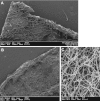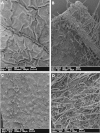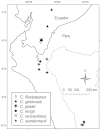Cuatrecasanthus (Vernonieae, Compositae): A revision of a north-central Andean genus
- PMID: 23170071
- PMCID: PMC3492924
- DOI: 10.3897/phytokeys.14.2520
Cuatrecasanthus (Vernonieae, Compositae): A revision of a north-central Andean genus
Abstract
Cuatrecasanthus is native to Ecuador and Peru and although several unusual characters define the genus, such as single flowered heads and corolla throat (limb) divided to the base with lobes that are thickened at the margins, the members of the genus were not recognized as especially closely related until relatively recently. All six species are described, including two new to science (Cuatrecasanthus kingii H. Rob. & V.A. Funk, sp. nov. and Cuatrecasanthus lanceolatus H. Rob. & V.A. Funk, sp. nov.), and one new combination is recognized (Cuatrecasanthus giannasii (Stutts) H. Rob. & V.A. Funk, comb. nov.). A key is provided along with images of the types, SEM photographs of the leaf surfaces, a distribution map, and illustrations of the two new species. All species are given a preliminary conservation status of Data Deficient in regard to the IUCN Red List of Threatened Species.
Keywords: Asteraceae; Critoniopsis; Ecuador; Neotropics; Peru.
Figures










References
-
- Chaudhri MN, Vegter IH, DeWal CM. (1972) Index Herbariorum part II(3), Collectors I-L. Regnum Vegetabile 86: 1-473
-
- Gleason HA. (1925) Studies on the flora of northern South America–V. Miscellaneous new or noteworthy species. Bulletin of the Torrey Botanical Club 52 (5): 181-196 doi: 10.2307/2479939 - DOI
-
- Hieronymus G [HEW] (1905) Plantae peruvianae a claro Constantino de Jelski collectae, Compositae. Botanische Jahrbücher für Systematik, Pflanzengeschichte und Pflanzengeographie 36 (5): 458-573
-
- Keeley SC, Forsman ZH, Chan R. (2007) A phylogeny of the “evil tribe” (Vernonieae: Compositae) reveals Old/New World long distance dispersal: Support from separate and combined congruent datasets (truL1, ndhF, ITS). Molecular Phylogenetics and Evolution 44 (1): 89-103 doi: 10.1016/j.ympev.2006.12.024 - DOI - PubMed
-
- Robinson H. (1989) Two new genera of Vernonieae (Asteraceae) from the northern Andes with dissected corolla limbs Cuatrecasanthus and Joseanthus. Revista de la Academia Colombiana de Ciencias exactas, Fisicas y Naturales 17 (65): 207-213
LinkOut - more resources
Full Text Sources
